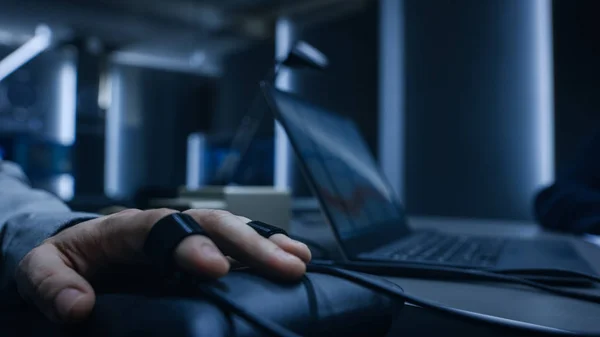If you are a polygraph test candidate and have concerns about its reliability or the outcome, it is only natural for you to begin looking for ways to beat the machine or control your results.
Any cursory internet search will bring up a wide variety of “hints” and “tricks” for how to beat it. Becoming quickly confused and overwhelmed by clearly unreliable advice is almost a guarantee. You’ll find detailed and fool proof techniques, while others will tell you that it is completely impossible to outsmart one. So, which one is it?
Here, we discuss the likelihood of you actually beating the test based on our own practical experience. We demonstrate the contradictory and incorrect information you can find, and we conclude with our own opinions.

The first step is understanding how the exam works. When taking a polygraph, a series of sensors will be attached to your body, including a blood pressure cuff, electrodes on your fingers, a respiratory belt, and sometimes monitors to check for leg or anal sphincter movements. These will measure your physiological responses, including heart rate, blood pressure, respiration, and perspiration.
During the test, you will be asked a series of questions that are designed to elicit emotional responses. The examiner will typically begin by asking you basic questions, such as your name and address, to establish a baseline for your physiological responses.
Next, he will ask a number of relevant questions that are related to the issue being investigated. For example, if the test is being used to determine whether you have committed a crime, the relevant question might be, “Were you present at the scene of the crime?”
Finally, he will ask a series of comparison questions that are designed to elicit physiological responses regardless of the situation. These might include questions like “Have you ever lied to someone you love?” or “Have you ever stolen anything?”. Most people will answer “no” to at least one of these questions that should have been answered “yes.” This is supposedly displayed as a blip on the polygraph machine that will serve as a signature of your lie.
The theory behind it is that when asked a relevant question vs. a control question, your body will respond more strongly if you are lying than if you are speaking the truth.
Is the test accurate?
The credibility of polygraphs was challenged almost as soon as they were invented in 1921, and ongoing debates about their accuracy have continued to the present. Numerous organizations, including the National Academy of Science, the US Congress Office of Technology Assessment, and the American Psychological Association, have questioned its accuracy. Even so, it is routinely used in many situations, such as employment screenings and interrogating criminal suspects.
Scientists and law enforcement believe there are a number of reasons why the test could be inaccurate, from poorly formulated questions to the examiner misreading results. That said, the accuracy is estimated to be between 88% and 98% with proper quality controls.
Conflicting claims regarding beating the polygraph test

Organizations, such as the American Psychological Association, claim that many people who have “beaten” the exam have a misapprehension of what beating it actually means.
Some believe that if the results are inconclusive, it has been beaten. However, that doesn’t mean they’ve been able to successfully lie; it only means there is no conclusion either way. This will usually lead to a re-test request.
Contrasting blogs and articles claim that it is possible to beat it if you are dealing with a novice examiner, but close to impossible if you are dealing with an experienced one.
They claim that if your tester isn’t seasoned yet, they may not be used to noticing the tell-tale signs that you are employing techniques that someone who has handled hundreds of exams will be able to spot both in the data and the behavior.
On the other hand, experienced ones know what websites and videos can teach when it comes to altering human physiology. They also know that it is difficult to learn how to alter what appears when it comes to displaying a genuine or natural response to an exam question.
Trying to change the body’s responses from normal reactions can, in many cases, create abnormal data that can be recognized by an experienced examiner.
In 2003, the National Review Council issued a statement explaining the credible evidence of an extremely high level of mental and physical countermeasure skills that would be required to beat a polygraph. This conclusion meant that they did not believe, based on a lack of evidence, that the test could be beaten.
Countermeasure types (professional terminology)

In one study, several tests were conducted to find which countermeasures examinees could use and if they were successful. There are four major types:
- General State
- Specific Point
- Spontaneous
- Information
General State Countermeasure
The general state CM would be used to alter mental and physical being. doing this by taking drugs, drinking alcohol, and taking relaxation or interfering agents. When using the general state, the examinee would not be focused on any specific point during the test.
Specific Point Countermeasure
The specific point CM is when attempting to reduce responses to relevant questions and increase responses to comparison questions. most likely by altering mental or physical responses.
Spontaneous Countermeasure
Spontaneous CM techniques are trying to influence the exam results without any planning or forethought. These include relaxation or meditation techniques, rationalization, imagery, controlling heart rate and breathing, staying calm, or even biting the tongue and pressing the toes at random times throughout the exam.
Information Countermeasure
The information CM is considered to be used when a candidate is seeking information prior to the test in an attempt to satisfy curiosity, hide deception, or ensure truth-telling is obvious; this is very common for both innocent and guilty individuals.
Drugs used to beat the test
A 1981 study found that a small dose of meprobamate, a commonly used tranquilizer, allowed people to lie without being detected. It was believed the tranquilizer effects would slow your physical reactions but keep you calm and alert during the exam.
Heart rate medications and blood pressure prescriptions, along with anti-anxiety, allergy, sleep, and cough medications, may affect the test, often leading to an inconclusive result. However, in the present day, there are many drugs that can be detected during the pre-screen drug check.
The most frequently found methods for beating the polygraph
- Controlled Breathing: This involves deliberately manipulating your breathing pattern to lower your physiological responses. The idea is to take deep, slow breaths during baseline questions and then speed up your breathing during relevant questions to simulate an increased physiological response.
- Muscle Tensing: This includes tensing your muscles during the baseline questions and then deliberately relaxing them during the relevant questions. The idea is to trick the polygraph into thinking that the relevant questions are less stressful than the baseline questions.
- Mental Countermeasures: Some people tried using mental techniques such as imagining calming scenes or repeating a mantra to themselves during the test. The idea is to reduce anxiety and stress responses that might trigger a false positive.
- Cognitive Behavioural Techniques: Cognitive behavioral methods involve learning to manage your thoughts and emotions in a way that reduces stress and anxiety.
More online advice on how to beat the test

As previously mentioned, searching the web will provide conflicting evidence and advice on how to beat the exam.
- One common “hack” is to create physical and emotional extremes in your behavior to skew the results. An example of this, provided by Russell Tice, the National Security Agency’s whistleblower, would be to bite your tongue while answering a question the examiner will expect you to lie about (the control question). He argues that increasing your physical reaction when lying about a harmless question will make your reaction when lying about an important query seem much less in comparison.
- Some articles will advise you to purposely quicken your breathing while answering a control question and then breathe normally again when you’ve moved on to the next query. Others will suggest poking your thumb or placing a needle in your shoe.
- You might find several blogs that suggest acting distraught throughout the entire test, no matter what questions are being asked. This is a common spontaneous countermeasure, used when thinking of upsetting circumstances, to keep your mood and demeanour unpredictable to the examiner.
In contrast to advice that being in a heightened emotional state or actual physical pain is the best route, some claim that a better approach is to remain as calm as possible, either by daydreaming, imagining your favorite place, or picturing whatever calms you to help control your physiological reactions.
Additional advice found online includes:
- Mentally alter the meaning of the questions being asked. For example, mentally reinterpret a relevant question as being about something entirely different in order to avoid feeling guilty about the response.
- Say only what you need to. Yes-or-no answers should be sufficient for most of your exam. You should not offer any more information than is absolutely necessary.
- Don’t admit to anything relevant. No matter what the lines on your chart look like, only your confession will be damaging. The examiner might try to convince you that they can “see” a lie in the polygraph results, but that isn’t totally accurate. Making sure you don’t admit anything that invites further questions gives you a better chance of appearing truthful.
- Alter your breathing rate in between questions by changing your breathing pattern, making it fast or slow, holding your breath, or breathing shallowly.
- Answer questions strangely or vaguely. This will make it difficult for the tester to get a read on what a “normal” response is for you.
- Think of something mentally stressful when answering irrelevant questions. You can modify the results showing “normal” responses actually distress you. An example would be mentally picturing a frightening scenario to increase your heart rate and breathing.
Analysis of the effectiveness of these countermeasures

Countermeasures have been around for as long as the tests exist. Some claimed success in deceiving the test, but the effectiveness of these is still a matter of debate.
One problem is that the efficiency of countermeasures can vary depending on countless factors, including the individual, the type of test being administered, the examiner, and more. For example, some techniques, such as controlled breathing or mental exercises, may work better for specific individuals than others. Similarly, certain ones may be more effective for specific types of tests, such as those focused on deception versus those focused on crime-related behavior.
Additionally, while some may work in the short term, they may not be effective in the long term. For example, a countermeasure that involves drinking large amounts of water before the test to dilute bodily fluids may work for one test, but the effects may not last for subsequent tests as the examiner may simply adjust the test parameters.
Research also shown that some can actually increase the likelihood of a false positives, meaning that an innocent person is incorrectly identified as deceptive. For example, ones that involve physical pain may trigger responses similar to those associated with deception.
Further studies about countermeasures
Over the years, several studies were conducted to evaluate the effectiveness of different countermeasures. Some of these focused on specific techniques, like mental countermeasures, while others examined broader methods, such as the use of anti-anxiety medications.
One carried out by the National Research Council found that even if an individual is successful in using a countermeasure, it may not necessarily result in a passing score on the test for reasons such as the skill of the examiner, the type of questions being asked, and the individual’s psychological and physiological state.
Another one conducted by the Department of Defence examined countermeasures such as controlled breathing and mental imagery. This study found that while some of them may, in rare cases, help pass the test, they are not reliable and could be detected by a skilled examiner.
Other studies looked at the use of drugs, such as beta-blockers, to manipulate physiological responses. While some shown that they may be effective in lowering an individual’s anxiety and stress levels, they also have potential side effects and can be easily detected by examiners.
Techniques and methods used to detect and counter countermeasures

- Behavioral observation: Examiners are trained to observe behavior during the test, such as changes in posture, fidgeting, or changes in breathing. Behavioral assessment can provide valuable information about an examinee’s state of mind.
- Eye-tracking: Eye-tracking technology can be used to determine whether an individual is trying to manipulate their physiological responses. For example, trying to mask their emotions, they may try to look away from the examiner when answering specific questions.
- Voice Stress Analysis: Voice stress analysis is used to detect changes in voice that may indicate deceit. It works by analyzing the frequency and amplitude of your voice. However, there is controversy surrounding the effectiveness of this, and it is not widely used.
- Psychological Evaluation: In addition to the physical testing, administrators may also evaluate psychological state. This can include assessing level of anxiety or stress, as well as particular motivation for passing the test.
- Follow-up questions: If the examiner detects any suspicious CMs during the test, they may ask follow-up questions to try to elicit a more honest response. For example, if your physiological response to a relevant question is unusually low, he may ask a follow-up question that is designed to elicit a stronger response.
- Follow-up interviews: After conducting the test, examiners may use follow-up interviews to clarify any discrepancies or inconsistencies in results. These can help them identify potential countermeasures used.
Beating the lie detector test: Our practical-based insights
Due to the various opinions, tricks, and tips offered from so many sources, it’s difficult to determine whether any of them will work for you, especially since there are no guarantees your examiner will be seasoned, that your strategy will be successful, or that you will not need to retake the exam after deciding to implement any of these.
You may be wondering if you can train yourself at home to beat the exam or hire someone to assist you in doing so. Our experience has shown us, that it is nearly impossible to beat the polygraph unless you have had substantial training (years) to do so, and even then, your chances might be very slim. This is due to one major fact: the authenticity of your physiological responses. The polygraph’s machine algorithm and the examiner observing the results are highly experienced at recognizing unusual physiological recordings; this is due to a combination of machine learning (with thousands of previous examinees) and human experience. So, basically, to beat a polygraph, you have to beat the machine’s experience and the examiner’s experience altogether, which, as mentioned, is close to impossible.
In trying to do so, you will most likely:
- Get a PNC (purposely non-cooperative) result, which will affect your application process or interrogation negatively.
- You will receive an “inconclusive” result, but will probably be asked to return and retake another polygraph exam.
While beating the polygraph may seem tempting to some, the best approach is to approach it with honesty and integrity. Focus on answering each question openly and to the best of your ability. An experienced examiner will be able to detect attempts to manipulate results. Rather than trying tricks and tips of questionable efficacy, have confidence that truthfulness is the smartest long-term strategy. Approaching it with a calm and focused mindset will lead to the most favorable outcome. With a combination of honesty, cooperation, and mental preparation, you can achieve success. Good luck!

